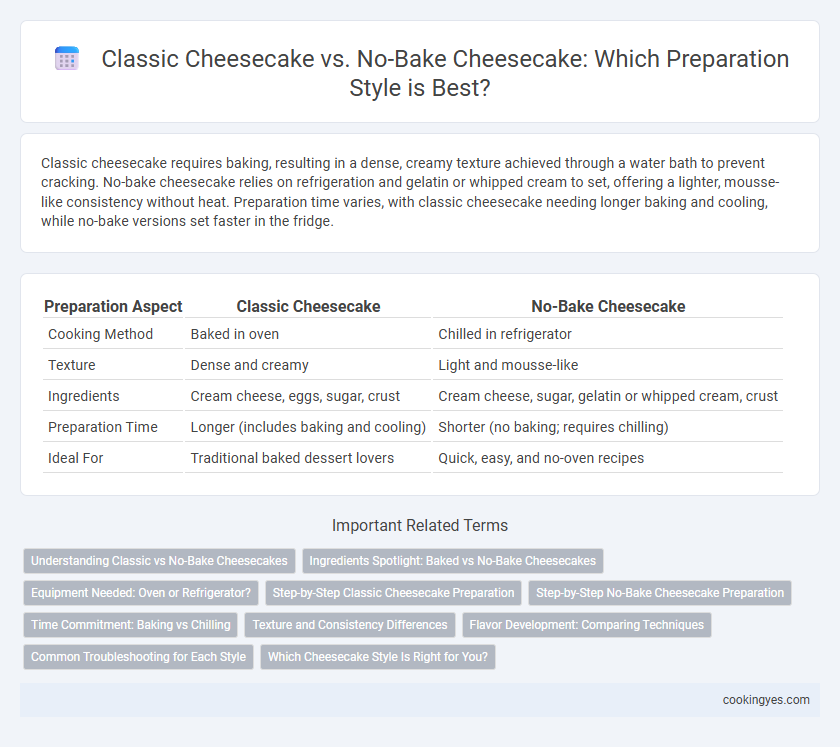Classic cheesecake requires baking, resulting in a dense, creamy texture achieved through a water bath to prevent cracking. No-bake cheesecake relies on refrigeration and gelatin or whipped cream to set, offering a lighter, mousse-like consistency without heat. Preparation time varies, with classic cheesecake needing longer baking and cooling, while no-bake versions set faster in the fridge.
Table of Comparison
| Preparation Aspect | Classic Cheesecake | No-Bake Cheesecake |
|---|---|---|
| Cooking Method | Baked in oven | Chilled in refrigerator |
| Texture | Dense and creamy | Light and mousse-like |
| Ingredients | Cream cheese, eggs, sugar, crust | Cream cheese, sugar, gelatin or whipped cream, crust |
| Preparation Time | Longer (includes baking and cooling) | Shorter (no baking; requires chilling) |
| Ideal For | Traditional baked dessert lovers | Quick, easy, and no-oven recipes |
Understanding Classic vs No-Bake Cheesecakes
Classic cheesecake features a baked preparation method, where a cream cheese mixture is combined with eggs and baked to create a dense, creamy texture with a firm crust. No-bake cheesecake relies on refrigeration to set, using gelatin or whipped cream as stabilizers, resulting in a lighter, mousse-like consistency without the need for oven time. Understanding these preparation styles highlights the differences in texture, firmness, and preparation complexity between classic and no-bake cheesecakes.
Ingredients Spotlight: Baked vs No-Bake Cheesecakes
Classic cheesecake relies on cream cheese, eggs, and sugar baked together to create a dense, rich texture that develops a slightly browned top. No-bake cheesecake combines cream cheese with whipped cream or gelatin to achieve a lighter, mousse-like consistency without the need for oven heat. The baked version requires precise temperature control to avoid cracks, while the no-bake version emphasizes refrigeration time for setting.
Equipment Needed: Oven or Refrigerator?
Classic cheesecake requires an oven for baking at a controlled temperature, ensuring a firm texture and rich flavor, while no-bake cheesecake relies solely on refrigeration to set, eliminating the need for heat. The oven in classic cheesecake recipes facilitates the combination of cream cheese, eggs, and sugar into a dense, creamy dessert with a slightly browned top. No-bake cheesecake uses gelatin or whipped cream to achieve a similar firmness, making a refrigerator essential for chilling and solidifying the dessert without any baking equipment.
Step-by-Step Classic Cheesecake Preparation
Classic cheesecake preparation involves baking a creamy mixture of cream cheese, eggs, sugar, and vanilla on a graham cracker crust at a moderate temperature, typically around 325degF (163degC), for about 45-60 minutes until the center is just set. The step-by-step method includes beating cream cheese until smooth, gradually adding eggs one at a time, mixing in sugar and flavorings, pouring over the crust, and carefully baking to prevent cracks. This contrasts with no-bake cheesecake, which requires chilling in the refrigerator to firm up, relying on gelatin or whipped cream instead of eggs and heat for structure.
Step-by-Step No-Bake Cheesecake Preparation
No-bake cheesecake preparation involves combining cream cheese, sugar, and whipped cream or gelatin to create a smooth filling without heating, then pouring it onto a graham cracker crust and chilling until set. Unlike classic cheesecake, which requires baking in an oven with eggs for a dense texture, no-bake cheesecake offers a lighter, creamier consistency achieved through refrigeration. This method appeals to those seeking a quick, hassle-free dessert without the risk of cracking or overbaking commonly associated with classic cheesecakes.
Time Commitment: Baking vs Chilling
Classic cheesecake requires a significant time commitment, with about 1 to 1.5 hours of baking followed by several hours of cooling and chilling to achieve the perfect texture. In contrast, no-bake cheesecake significantly reduces preparation time by eliminating the baking step, needing only around 4 to 6 hours of chilling to set. This makes no-bake cheesecake a faster, more convenient option for busy schedules while maintaining creamy consistency.
Texture and Consistency Differences
Classic cheesecake features a dense, creamy texture achieved through baking, which allows the proteins in the cream cheese and eggs to set firmly. No-bake cheesecake offers a lighter, mousse-like consistency due to its reliance on chilled gelatin or whipped cream for structure instead of heat. The preparation style directly influences the mouthfeel, with baked versions providing a rich, velvety bite and no-bake variations delivering a softer, fluffier profile.
Flavor Development: Comparing Techniques
Classic cheesecake develops a rich, deep flavor through baking, which allows the ingredients to meld and intensify over time. No-bake cheesecake relies on chilling to set, preserving a lighter, fresher taste with less complex flavor layers. The choice of preparation style directly impacts the texture and overall flavor profile, with baked versions offering creamier, denser richness and no-bake varieties delivering tangy, airy sweetness.
Common Troubleshooting for Each Style
Classic cheesecake often faces common issues like cracking due to overbaking or sudden temperature changes, with water baths and gradual cooling helping to prevent these problems. No-bake cheesecake can experience problems such as improper setting or a runny texture, typically resolved by ensuring sufficient chilling time and using the correct ratio of gelatin or stabilizers. Understanding these preparation nuances helps achieve the ideal creamy texture and smooth finish specific to each cheesecake style.
Which Cheesecake Style Is Right for You?
Classic cheesecake requires baking, resulting in a dense, creamy texture with a rich flavor, while no-bake cheesecake relies on refrigeration to set, offering a lighter, mousse-like consistency. If you seek a traditional, indulgent dessert and have time for oven baking, classic cheesecake suits your preference; for a quicker, fuss-free option with minimal equipment, no-bake cheesecake is ideal. Both styles accommodate various toppings and crust choices, allowing customization based on taste and preparation convenience.
Classic cheesecake vs no-bake cheesecake for preparation style Infographic

 cookingyes.com
cookingyes.com